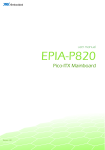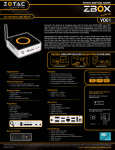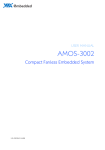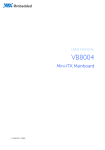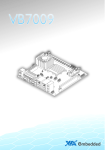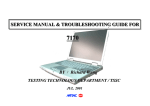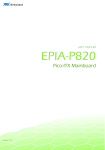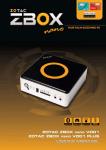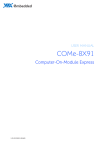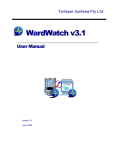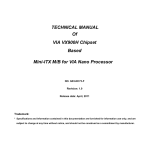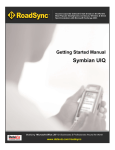Download User`s Manual
Transcript
USER MANUAL EPIA-P900 Pico-ITX embedded board 1.14-06242013-145500 Copyright Copyright © 2013 VIA Technologies Incorporated. All rights reserved. No part of this document may be reproduced, transmitted, transcribed, stored in a retrieval system, or translated into any language, in any form or by any means, electronic, mechanical, magnetic, optical, chemical, manual or otherwise without the prior written permission of VIA Technologies, Incorporated. Trademarks All trademarks are the property of their respective holders. Disclaimer No license is granted, implied or otherwise, under any patent or patent rights of VIA Technologies. VIA Technologies makes no warranties, implied or otherwise, in regard to this document and to the products described in this document. The information provided in this document is believed to be accurate and reliable as of the publication date of this document. However, VIA Technologies assumes no responsibility for the use or misuse of the information (including use or connection of extra device/equipment/add-on card) in this document and for any patent infringements that may arise from the use of this document. The information and product specifications within this document are subject to change at any time, without notice and without obligation to notify any person of such change. VIA Technologies, Inc. reserves the right the make changes to the products described in this manual at any time without prior notice. Regulatory Compliance FCCFCC-A Radio Frequency Interference Statement This equipment has been tested and found to comply with the limits for a class A digital device, pursuant to part 15 of the FCC rules. These limits are designed to provide reasonable protection against harmful interference when the equipment is operated in a commercial environment. This equipment generates, uses, and can radiate radio frequency energy and, if not installed and used in accordance with the instruction manual, may cause harmful interference to radio communications. Operation of this equipment in a residential area is likely to cause harmful interference, in which case the user will be required to correct the interference at his personal expense. Notice 1 The changes or modifications not expressly approved by the party responsible for compliance could void the user's authority to operate the equipment. Notice 2 Shielded interface cables and A.C. power cord, if any, must be used in order to comply with the emission limits. Notice 3 The product described in this document is designed for general use, VIA Technologies assumes no responsibility for the conflicts or damages arising from incompatibility of the product. Check compatibility issue with your local sales representatives before placing an order. Tested To Comply With FCC Standards FOR HOME OR OFFICE USE Battery Recycling and Disposal Only use the appropriate battery specified for this product. Do not re-use, recharge, or reheat an old battery. Do not attempt to force open the battery. Do not discard used batteries with regular trash. Discard used batteries according to local regulations. Safety Precautions Always read the safety instructions carefully. Keep this User's Manual for future reference. All cautions and warnings on the equipment should be noted. Keep this equipment away from humidity. Lay this equipment on a reliable flat surface before setting it up. Make sure the voltage of the power source and adjust properly 110/220V before connecting the equipment to the power inlet. Place the power cord in such a way that people cannot step on it. Always unplug the power cord before inserting any add-on card or module. If any of the following situations arises, get the equipment checked by authorized service personnel: The power cord or plug is damaged. Liquid has penetrated into the equipment. The equipment has been exposed to moisture. The equipment has not worked well or you cannot get it work according to User's Manual. The equipment has dropped and damaged. The equipment has obvious sign of breakage. Do not leave this equipment in an environment unconditioned or in a storage temperature above 60°C (140°F). The equipment may be damaged. Do not leave this equipment in direct sunlight. Never pour any liquid into the opening. Liquid can cause damage or electrical shock. Do not place anything over the power cord. Do not cover the ventilation holes. The openings on the enclosure protect the equipment from overheating EPIAEPIA-P900 User Manual Box Contents and Ordering Information EPIAEPIA-P900P900-10 1 x EPIA-P900 embedded board (with VIA Eden™ X2 U4200 @ 1.0+ GHz NanoBGA2 processor) 1 x P830-A I/O card (pre-assembled companion card) 1 x SATA data cable (P/N: 99G33-240103) 1 x SATA power cable (P/N: 99G33-020985) 1 x DC-in cable (P/N: 99G33-250024) iv EPIAEPIA-P900 User Manual Table of Contents 1. Product Overview ................................................................ ................................................................................................ ................................................................ 1 1.1. Key Features and Benefits........................................................................... 2 1.1.1. VIA Eden™ X2 Processor ....................................................................... 2 1.1.2. VIA VX900H Chipset.............................................................................. 2 1.1.3. Expansion Option ................................................................................... 2 1.2. Product Specifications................................................................................. 4 1.3. Layout Diagram ............................................................................................. 7 1.4. Product Dimensions..................................................................................... 9 1.5. Height Distribution..................................................................................... 10 2. I/O Interface................................ Interface................................................................ ................................................................................................ ........................................................................ ........................................ 11 2.1. External I/O Ports ....................................................................................... 11 2.1.1. HDMI® Port............................................................................................. 12 2.1.2. VGA Port................................................................................................. 13 2.1.3. USB 2.0 Port ........................................................................................... 14 2.1.4. RJ45 LAN port: Gigabit Ethernet ....................................................... 14 2.2. Onboard Connectors ................................................................................ 16 2.2.1. LVDS Connector.................................................................................... 16 2.2.2. VGA and USB combination pin header ........................................... 18 2.2.3. SATA Connectors ................................................................................. 19 2.2.4. SATA Power Connector ...................................................................... 20 2.2.5. USB and USB Device Combination Pin Header.............................. 21 2.2.6. LAN pin header ..................................................................................... 23 2.2.7. UART Connectors ................................................................................. 24 2.2.8. LPC, SMBus, and GPIO Combination Pin Header .......................... 25 2.2.9. SPI Flash Connector.............................................................................. 27 2.2.10. CMOS Battery Connector.................................................................... 28 2.2.11. Front Panel and PS2 Combination Pin Header................................. 29 2.2.12. Front Audio Pin Header....................................................................... 30 2.2.13. CPU Fan Connector .............................................................................. 31 v EPIAEPIA-P900 User Manual 2.2.14. DC-In Power Connector ...................................................................... 32 3. Jumpers ................................................................ ................................................................................................ ............................................................................... ............................................... 33 3.1. Clear CMOS Jumper.................................................................................. 33 3.2. Panel Power Select Jumper ..................................................................... 35 3.3. Backlight Power Select Jumper............................................................... 36 4. Expansion Slots ................................................................ ................................................................................................ .................................................................. .................................. 37 4.1. PCIe and USB Combination Connector................................................. 37 4.2. DDR3 SODIMM Memory Slot.................................................................. 39 4.2.1. Installing a Memory Module .............................................................. 40 4.2.2. Removing a Memory Module............................................................. 42 5. Hardware Installation ................................................................ ........................................................................................ ........................................................ 43 5.1. Removing and Installing the P830-A Companion Card..................... 43 5.1.1. Removing the P830-A .......................................................................... 43 5.1.2. Installing the P830-A............................................................................ 45 5.2. Installing the P830-B Expansion Card.................................................... 47 5.3. Installing into a Chassis............................................................................. 48 5.3.1. Suggested minimum chassis dimensions ......................................... 48 5.3.2. Suggested minimum chassis height................................................... 49 5.3.3. Suggested keepout areas .................................................................... 50 6. BIOS Setup Utility ................................................................ .............................................................................................. .............................................................. 51 6.1. Entering the BIOS Setup Utility............................................................... 51 6.2. Control Keys................................................................................................ 51 6.3. Getting Help................................................................................................ 52 6.4. System Overview........................................................................................ 53 6.4.1. AMIBIOS.................................................................................................. 53 6.4.2. Processor................................................................................................. 53 6.4.3. System Memory ..................................................................................... 53 6.4.4. System Time ........................................................................................... 53 6.4.5. System Date............................................................................................ 54 vi EPIAEPIA-P900 User Manual 6.5. Advanced Settings ..................................................................................... 55 6.5.1. CPU Configuration ................................................................................ 57 6.5.2. SATA Configuration.............................................................................. 59 6.5.3. SuperIO Configuration ......................................................................... 61 6.5.4. Hardware Health Configuration ........................................................ 62 6.5.5. ACPI Configuration ............................................................................... 63 6.5.6. APM Configuration................................................................................ 65 6.5.7. Event Log Configuration ...................................................................... 70 6.5.8. Spread Spectrum Configuration ........................................................ 71 6.5.9. USB Configuration................................................................................. 72 6.5.10. CRB Configuration................................................................................. 73 6.6. Boot Settings ............................................................................................... 77 6.6.1. Boot Settings Configuration................................................................ 77 6.6.2. Boot Device Priority.............................................................................. 79 6.7. Security Settings ......................................................................................... 80 6.7.1. Change Supervisor Password ............................................................. 80 6.7.2. Change User Password ........................................................................ 80 6.7.3. Clear User Password ............................................................................ 81 6.7.4. Password Check .................................................................................... 81 6.8. Exit Options................................................................................................. 82 6.8.1. Save Changes and Exit ......................................................................... 82 6.8.2. Discard Changes and Exit.................................................................... 82 6.8.3. Discard Changes.................................................................................... 82 6.8.4. Load Optimal Defaults ........................................................................ 82 7. Driver Installation................................ Installation................................................................ ............................................................................................... ............................................................... 85 7.1. Microsoft Driver Support.......................................................................... 85 7.2. Linux Driver Support.................................................................................. 85 Appendix A. Power Consumption Report................................ Report............................................................... ............................................................... 87 A.1. EPIA-P900-10....................................................................................................... 87 A.1.1. Burn-in 3DMark06, 1280 x 1024 (Demo mode)................................... 88 A.1.2. PassMark Burn-in (CPU usage = 100%).................................................. 88 vii EPIAEPIA-P900 User Manual A.1.3. Power DVD 10 to Player H.264 1080i_10M Movie ............................ 88 A.1.4. Power DVD 10 to Player MPEG2 1080P_40M Movie ............................. 88 A.1.5. Idle at Windows 7 x64 .............................................................................. 88 A.1.6. Suspend S1................................................................................................... 89 A.1.7. Suspend S3................................................................................................... 89 A.1.8. Suspend S4................................................................................................... 89 A.1.9. Suspend S5................................................................................................... 89 Appendix B. Pin Header and Connector Vendor Vendor Lists................................ Lists........................................... ........................................... 91 B.1. EPIA-P900 Mainboard ........................................................................................ 91 B.2. Mating Connector Vendor Lists ....................................................................... 93 viii EPIAEPIA-P900 User Manual Lists of Figures Figure 1: Layout diagram of the EPIA-P900 mainboard (top and bottom view) 7 Figure 2: Mounting holes and dimensions of the EPIA-P900 .................................. 9 Figure 3: Height distribution of the EPIA-P900 mainboard.................................... 10 Figure 4: External I/O ports........................................................................................... 11 Figure 5: HDMI® port pinout diagram......................................................................... 12 Figure 6: VGA port pinout diagram............................................................................. 13 Figure 7: USB port pinout diagram .............................................................................. 14 Figure 8: Gigabit Ethernet port pinout diagram ....................................................... 14 Figure 9: LVDS connector.............................................................................................. 16 Figure 10: VGA and USB combination pin header .................................................. 18 Figure 11: SATA connectors ......................................................................................... 19 Figure 12: SATA power connector.............................................................................. 20 Figure 13: USB and USB Device pin header .............................................................. 21 Figure 14: LAN pin header ............................................................................................ 23 Figure 15: UART connectors ......................................................................................... 24 Figure 16: LPC, SMBus and GPIO combination pin header ................................... 25 Figure 17: SPI connector ................................................................................................ 27 Figure 18: CMOS battery connector ........................................................................... 28 Figure 19: Front panel and PS2 combination pin header....................................... 29 Figure 20: Front audio pin header ............................................................................... 30 Figure 21: CPU fan connector....................................................................................... 31 Figure 22: DC-In power connector ............................................................................. 32 Figure 23: CLEAR CMOS jumper ................................................................................. 33 Figure 24: LVDS panel power select jumper............................................................ 35 Figure 25: Backlight power select jumper................................................................. 36 Figure 26: PCIe and USB combination connector .................................................... 37 Figure 27: DDR3 SODIMM memory slot.................................................................... 39 Figure 28: Inserting the memory module................................................................... 40 Figure 29: Locking the memory module .................................................................... 40 Figure 30: Installing memory thermal pad ................................................................ 41 Figure 31: Disengaging the SODIMM locking clips ................................................. 42 ix EPIAEPIA-P900 User Manual Figure 32: Removing the memory module ................................................................ 42 Figure 33: Unscrewing the P830-A companion card............................................... 43 Figure 34: Pulling the P830-A companion card ....................................................... 44 Figure 35: Aligning the P830-A companion card..................................................... 45 Figure 36: Connecting P830-A companion card ...................................................... 46 Figure 37: Securing the P830-A companion card .................................................... 46 Figure 38: Installing the P830-B expansion card ...................................................... 47 Figure 39: Suggested minimum chassis dimensions ................................................ 48 Figure 40: Suggested minimum internal chassis ceiling height............................. 49 Figure 41: Suggested keepout areas ........................................................................... 50 Figure 42: Illustration of the Main menu screen....................................................... 53 Figure 43: Illustration of the Advanced Settings screen......................................... 55 Figure 44: Illustration of the CPU Configuration screen......................................... 57 Figure 45: Illustration of SATA Configuration screen ............................................. 59 Figure 46: Illustration of SATA-1 Primary IDE screen ............................................. 59 Figure 47: Illustration of SuperIO Configuration screen......................................... 61 Figure 48: Illustration of Hardware Health Configuration screen ........................ 62 Figure 49: Illustration of ACPI Configuration screen ............................................... 63 Figure 50: Illustration of APM Configuration screen ............................................... 65 Figure 51: Illustration of Event Log Configuration screen...................................... 70 Figure 52: Illustration of Spread Spectrum Configuration screen ........................ 71 Figure 53: Illustration of USB Configuration screen ................................................ 72 Figure 54: Illustration of CRB Configuration screen................................................. 73 Figure 55: Illustration of Boot Settings screen.......................................................... 77 Figure 56: Illustration of Boot Settings Configuration............................................. 77 Figure 57: Illustration of Boot Device Priority........................................................... 79 Figure 58: Illustration of Security Settings screen.................................................... 80 Figure 59: Illustration of Exit Options screen ........................................................... 82 x EPIAEPIA-P900 User Manual Lists of Tables Table 1: Layout diagram description table of the EPIA-P900 mainboard............ 8 Table 2: Layout diagram description table of external I/O ports ........................ 11 Table 3: HDMI® port pinout ......................................................................................... 12 Table 4: VGA port pinout ............................................................................................. 13 Table 5: USB 2.0 port pinout........................................................................................ 14 Table 6: Gigabit Ethernet port pinout ........................................................................ 14 Table 7: Gigabit Ethernet LED color definition ........................................................ 15 Table 8: LVDS connector pinout ................................................................................. 17 Table 9: VGA and USB combination pin header pinout ........................................ 18 Table 10: SATA connector pinouts............................................................................. 19 Table 11: SATA power connector pinout................................................................. 20 Table 12: USB and USB Device pin header pinout ................................................. 21 Table 13: LAN pin header pinout................................................................................ 23 Table 14: UART connector pinouts ............................................................................ 24 Table 15: LPC, SMBus and GPIO combination pin header pinout....................... 26 Table 16: SPI connector pinout ................................................................................... 27 Table 17: CMOS battery connector pinout .............................................................. 28 Table 18: Front panel and combination pin header pinout .................................. 29 Table 19: Front audio pin header pinout................................................................... 30 Table 20: CPU fan connector pinout .......................................................................... 31 Table 21: DC-In power connector pinout................................................................. 32 Table 22: CLEAR CMOS jumper settings................................................................... 33 Table 23: LVDS panel power select jumper settings ............................................. 35 Table 24: Backlight power select jumper settings .................................................. 36 Table 25: PCIe and USB combination connector pinout ....................................... 38 Table 26: Serial port addresses and IRQs ................................................................. 61 Table 27: Panel types resolution................................................................................. 74 Table 28: EPIA-P900 pin header and connector vendor lists ............................... 92 Table 29: EPIA-P900 mating connector vendor lists............................................... 93 xi EPIAEPIA-P900 User Manual 1. Product Overview The VIA EPIA-P900 Pico-ITX mainboard is a compact native x86 mainboard optimized for systems in embedded and multimedia applications. It can also be used for various domain applications such as medical PC, industrial PC, and etc. The mainboard is based on the VIA VX900H Unified Digital Media IGP chipset that features the VIA Chrome™ 9 HD with 2D/3D graphics and video accelerators for rich digital media performance. The VIA EPIA-P900 mainboard has integrated HDMI® port and comes with preinstalled I/O companion card called P830-A, and an optional P830-B expansion card. The P830-A I/O companion card is connected through onboard pin headers carrying the back panel I/O such as VGA port, RJ45 LAN port and USB 2.0 ports. The P830-B expansion card provides two Mini PCIe x1 slots. The VIA EPIA-P900 has a powerful, secure, and efficient VIA Eden™ X2 dual core processor. The VIA Eden™ X2 processor includes the VIA AES Security Engine, VIA CoolStream™ Architecture and VIA PowerSaver™ Technology. The VIA EPIA-P900 includes one 1066 MHz DDR3 SODIMM slot that support up to 4 GB memory size. The VIA EPIA-P900 provides support for high fidelity audio with its included VIA VT2021 High Definition Audio codec. In addition it supports two SATA 3Gb/s storage devices and fully compatible with Microsoft® and Linux operating systems. 1 EPIAEPIA-P900 User Manual 1.1. Key Features and Benefits 1.1.1. VIA Eden™ X2 Processor The VIA Eden X2 is a 64-bit superscalar x86 dual core processor based on a 40 nanometer process technology. Packed into an ultra compact NanoBGA2 package (measuring 21mm x 21mm), it delivers an energy-efficient yet powerful performance, with cool and quiet operation. The VIA Eden X2 is ideal for embedded system applications such as industrial PCs, test machines, measuring equipment, digital signage, medical PCs, monitoring systems, gaming machines, in-vehicle entertainment, etc. Note: For Windows 7 and Windows Server 2008 R2 users only: If encounter the issue such as the operating system does recognize the VIA Dual-Core CPU as two processors instead of one processor with two cores. Download and install the hotfix released by Microsoft to address this issue. The downloadable hotfix is available at http://support.microsoft.com/kb/2502664 1.1.2. VIA VX900H Chipset The VIA VX900H Unified Digital Media Chipset is designed to enable high quality digital video streaming and DVD playback in a new generation of fanless, small form factor PCs and IA devices. The VIA VX900H features VIA Chrome™ 9 HD with 2D/3D graphics and video acceleration, DDR3 1066/800 support, motion compensation and dual display support to ensure a rich overall entertainment experience. 1.1.3. Expansion Option The EPIA-P900 further proves its versatility by providing an expansion option connector that uses a “PCIe and USB 2.0 combinations board-to-board connector” for P830-B expansion card. The P830-B expansion card provides two Mini-PCIe x1 slots. 2 EPIAEPIA-P900 User Manual The companies using the EPIA-P900 with P830-B expansion card obtain the maximum benefits and enable to slowly roll out upgrades as necessary instead of having to replace everything all at once. 3 EPIAEPIA-P900 User Manual 1.2. Product Specifications Processor VIA Eden X2 1.0+ GHz NanoBGA2 (for EPIA-P900-10 SKU) Supports 800MHz Front Side Bus X86 and x64 compatible 21 mm x 21 mm FCBGA Chipset VIA VX900H Unified Digital Media IGP chipset 31 mm x 31 mm FCBGA Graphics Integrated VIA Chrome™ 9 HD 3D/2D AGP graphics MPEG2, WMV9/VC1, H.264 Full HD video decoder System Memory 1 x SODIMM slot supporting DDR3 1066/800 Supports up to 4 GB memory size Onboard Peripherals Serial ATA Supports up to 3 Gb/s Onboard LAN VIA VT6130 PCIe Gigabit Ethernet controller Onboard Audio VIA VT2021 High Definition Audio Codec Onboard Super II/ /O Fintek F81801U-I Super I/O controller Onboard I/O Connectors 1 x USB 2.0 pin headers for 5 addition USB 2.0 ports and 1 USB 2.0 device port 1 x Single-channel 18/24-bit LVDS panel connector 1 x VGA and USB combination pin header (supports two USB 2.0 ports and one VGA port) 1 x Gigabit LAN pin header 1 x LPC, SMBus and DIO (GPI x4, GPO x4) combination pin header 1 x Front panel and PS2 combination pin header 1 x Audio pin header for Line-Out, Line-In and MIC-In 1 x PCIe and USB combination board-to-board connector for P830-B expansion module 4 EPIAEPIA-P900 User Manual 2 x SATA connectors 1 x SATA power connector 1 x CPU fan connector 2 x UART pin headers 1 x SPI connector 1 x LVDS panel power selector jumper (5V/3.3V) 1 x LVDS backlight voltage selector jumper (5V/12V) 1 x CMOS external battery connector 1 x DC-In power connector (+12V±5%) Back Panel I/O ® 1 x HDMI port 1 x VGA port (on P830-A) 1 x GigaLAN port (on P830-A) 2 x USB 2.0 ports (on P830-A) BIOS AMI BIOS 8 Mbit SPI flash memory Supported Operating System Microsoft Windows 7 Microsoft Windows Embedded Standard/Compact Linux System Monitoring & Management Wake-on-LAN Keyboard-Power-on, Timer-Power-on System Power Management AC power failure recovery Watchdog Timer Smart Fan for CPU fan Operating Conditions Operating Temperature 0°C up to 60°C Operating Humidity 0% ~ 95% (relative humidity; non-condensing) Form Factor Pico-ITX (10 cm x 7.2 cm) 5 EPIAEPIA-P900 User Manual Compliance CE FCC RoHS 6 EPIAEPIA-P900 User Manual 1.3. Layout Diagram Figure 1: Layout diagram of the EPIAEPIA-P900 mainboard (top and bottom view) 7 EPIAEPIA-P900 User Manual Item Description 1 FAN1: CPU fan 2 CN5: LPC, SMBus, and GPIO combination pin header 3 CN4: Front panel and PS2 combination pin header 4 CN2: USB, and USB Device combination pin header 5 CN1: Audio pin header 6 PWR2: SATA power connector 7 J1: UART port 2 8 SATA1, SATA2: SATA 3Gb/s connectors 9 CN6: PCIe and USB 2.0 combination connector 10 CN3: LAN pin header 11 JM1: Clear CMOS jumper 12 HDMI1: HDMI® port 13 VGA_USB1: VGA and USB combination pin header 14 VX900H chipset 15 JM2 LCD power selector 16 JM3: Backlight power selector 17 PWR1: DC-in power connector 18 VIA Eden X2 CPU 19 J2: UART port 1 20 SODIMM1: DDR3 SODIMM slot 21 LVDS1: LVDS connector 22 BAT1: CMOS battery connector 23 J3: SPI connector Table 1: Layout diagram description description table of the EPIAEPIA-P900 mainboard 8 EPIAEPIA-P900 User Manual 1.4. Product Dimensions 100.00 82.00 66.60 25.00 8.20 15.10 1.87 13.38 8.10 Figure 2: Mounting holes and dimensions of the EPIAEPIA-P900 9 EPIAEPIA-P900 User Manual 1.5. Height Distribution Figure 3: Height distribution of the EPIA EPIAIA-P900 mainboard 10 EPIAEPIA-P900 User Manual 2. I/O Interface The VIA EPIA-P900 has a wide selection of interfaces. It includes a selection of frequently used ports as part of the external I/O coastline. 2.1. External I/O Ports Figure 4: External I/O ports Item Item Description 1 VGA1: VGA port (on P830-A) 2 USB1, USB2: USB 2.0 ports (on P830-A) 3 HDMI1: HDMI® port 4 RJ1: Gigabit LAN port (on P830-A) Table 2: Layout diagram description table of external I/O ports 11 EPIAEPIA-P900 User Manual 2.1.1. HDMI® Port The integrated 19-pin HDMI® port uses an HDMI® Type A receptacle connector as defined in the HDMI® specification. The HDMI® port is for connecting to HDMI® displays. The pinout of the HDMI® port is shown below. Figure 5: HDMI® port pinout pinout diagram Pin Signal Pin Signal 1 HDMITX2+ 2 GND 3 HDMITX2- 4 HDMITX1+ 5 GND 6 HDMITX1- 7 HDMITX0+ 8 GND 9 HDMITX0- 10 HDMITXC+ 11 GND 12 HDMITXC- 13 NC 14 NC 15 SPCLK 16 SPDAT 17 GND 18 PVDD5 19 -DP1_HPD Table 3: HDMI® port pinout 12 EPIAEPIA-P900 User Manual 2.1.2. VGA Port The 15-pin VGA port uses a female DE-15 connector. The VGA port is for connecting to analog displays. The pinout of the VGA port is shown below. Figure 6: VGA port pinout diagram Pin Signal Pin Signal 1 VGA-R 9 +5VCRT 2 VGA-G 10 Ground 3 VGA-B 11 NC 4 NC 12 VGA-SPD 5 Ground 13 VGA_HS 6 Ground 14 VGA_VS 7 Ground 15 VGA-SPCLK 8 Ground Table 4: VGA port pinout 13 EPIAEPIA-P900 User Manual 2.1.3. USB 2.0 Port There are two integrated USB 2.0 ports located below the RJ45 LAN port at the external I/O panel. The USB 2.0 interface port gives complete Plug and Play and hot swap capability for external devices and it complies with USB UHCI, rev. 2.0. Each USB port is using the USB Type A receptacle connector. The pinout of the typical USB port is shown below. Pin Signal 1 +5VSUS 2 Data- 3 Data+ 4 Ground Table 5: USB 2.0 port pinout Figure 7: USB port pinout diagram 2.1.4. RJ45 LAN port: Gigabit Ethernet The integrated 8-pin Gigabit Ethernet port is using an 8 Position 8 Contact (8P8C) receptacle connector (commonly referred to as RJ45). The Gigabit Ethernet ports are controlled by VIA Fast Ethernet controller. The pinout of the Gigabit Ethernet port is shown below. Pin Signal 1 Signal pair 1+ 2 Signal pair 1- 3 Signal pair 2+ 4 Signal pair 3+ 5 Signal pair 3- 6 Signal pair 2- 7 Signal pair 4+ 8 Signal pair 4- Table 6: Gigabit Ethernet port pinout Figure 8: Gigabit Ethernet port pinout diagram The RJ-45 port has two individual LED indicators located on the front side to show its Active/Link status and Speed status. 14 EPIAEPIA-P900 User Manual Link Off Link LED (Left LED on RJ RJ--45 connector) Active LED (Right LED on RJRJ-45 connector) Off Off The LED is always On in either Green or Orange colors Flash in Yellow color Speed_100Mbit The LED is always On in Green color Flash in Yellow color Speed_1000Mbit The LED is always On in Orange color Flash in Yellow color Speed_10Mbit Table 7: Gigabit Ethernet LED color definition definition 15 EPIAEPIA-P900 User Manual 2.2. Onboard Connectors 2.2.1. LVDS Connector The mainboard has one 24-pin LVDS panel connector on the bottom side. The onboard LVDS panel connector allows to connect the panel’s LVDS cable to support the single-channel 18-bit/24-bit display. Backlight controls are integrated into the LVDS panel connector pinout. The LVDS panel connector is labeled as “LVDS1”. The pinout of the connector is shown below. Figure 9: LVDS connector Pin Signal Pin Signal 1 LVDSD0- 2 LVDSD1- 3 LVDSD0+ 4 LVDSD1+ 5 GND 6 GND 7 PVDD2 8 LVDSD2- 9 PVDD2 10 LVDSD2+ 11 LCD1_DATA 12 GND 13 LCD1_CLK 14 LVDSCLK+ 15 GND 16 LVDSCLK- 16 EPIAEPIA-P900 User Manual 17 VDD_BL 18 GND 19 VDD_BL 20 LVDSD3- 21 BLEN_1 22 LVDSD3+ 23 BAK_ADJ 24 GND Table 8: LVDS connector pinout 17 EPIAEPIA-P900 User Manual 2.2.2. VGA and USB combination pin header The VGA and USB combination pin header block labeled as VGA_USB1 is used to connect to the P830-A companion card. The pin header block provides support for one VGA port and two USB 2.0 ports. The pinout of the VGA and USB combination pin header is shown below. CPU VIA Eden X2 VX900H VGA_USB1 1 Figure 10: 10: VGA and USB combination pin header Pin Signal Pin Signal 1 REDN 2 +5VCRT 3 GREENN 4 GND 5 BLUEN 6 DDCDATAN 7 GND 8 DDCCLKN 9 VGP_IO 10 VS 11 HS 12 GND 13 +5VSUS_USB 14 GND 15 USBHP5- 16 USBHP4- 17 USBHP5+ 18 USBHP4+ Table 9: VGA and USB combination pin header pinout 18 EPIAEPIA-P900 User Manual 2.2.3. SATA Connectors The two SATA connectors onboard can support up to 3 Gb/s transfer speeds. Both SATA connectors have a 7th pin1 that can provide +5V power to a SATA Disk-on-Module (DOM). When a regular SATA hard drive is connected, the 7th pin will be a ground pin. The SATA connectors are labeled as “SATA1” and “SATA2”. The pinout of the SATA connectors are shown below. SATA1 1 1 CPU VIA Eden X2 VX900H SATA2 Figure 11: 11: SATA connectors connectors SATA1 SATA2 Pin Signal Pin Signal 1 GND 1 GND 2 STXP_0 2 STXP_1 3 STXN_0 3 STXN_1 4 GND 4 GND 5 SRXN_0 5 SRXN_1 6 SRXP_0 6 SRXP_1 7 GND/+5V 7 GND/+5V Table 10: 10: SATA connector pinouts Note: 1. The SATA connector pin 7 default setting is GND. The +5V supports is a factory option. 19 EPIAEPIA-P900 User Manual 2.2.4. SATA Power Connector The onboard SATA power connector provides both +5V and +12V directly through the mainboard to the SATA drives. The SATA power connector is labeled as “PWR2”. The pinout of the SATA power connector is shown below. PWR2 1 CPU VIA Eden X2 VX900H Figure 12: 12: SATA power connector Pin Signal 1 +5V 2 +12V 3 GND Table 11: 11: SATA power connector pinout 20 EPIAEPIA-P900 User Manual 2.2.5. USB and USB Device Combination Pin Header The mainboard has one USB and USB Device combination pin header block enables the addition of five more USB 2.0 ports and one USB Device port. The pin header block is labeled as “CN2”. The pinout of the pin header is shown below. CN2 1 CPU VIA Eden X2 VX900H Figure 13: 13: USB and USB Device pin header Pin Signal Pin Signal 1 GND 2 GND 3 GND 4 GND 5 USB_VD0+ 6 USB_VD6+ 7 USB_VD0- 8 USB_VD6- 9 +5VSUS_USB 10 +5VSUS_USB 11 USB_VD1- 12 USB_VD3- 13 USB_VD1+ 14 USB_VD3+ 15 +5VUSBD 16 +5VSUS_USB 17 USBDP+ 18 USB_VD2+ 19 USBDP- 20 USB_VD2-- Table 12: 12: USB and USB Device pin pin header pinout 21 EPIAEPIA-P900 User Manual Note: USB Device port is a reserved feature. Contact sales for specific support. 22 EPIAEPIA-P900 User Manual 2.2.6. LAN pin header The onboard LAN pin header block is used to connect to the P830-A companion card. The pin header block labeled as “CN3” provides support for one RJ45 Gigabit Ethernet port. The pin header pinout is shown below. CPU VIA Eden X2 VX900H CN3 1 Figure 14: 14: LAN pin header Pin Signal Pin Signal 1 VDDTXRX 2 AVDD33 3 TD2- 4 TD3- 5 TD2+ 6 TD3+ 7 TD0- 8 TD1- 9 TD0+ 10 TD1+ 11 GND 12 LED1 13 LED2 14 LNK_ACT Table 13: 13: LAN pin pin header pinout 23 EPIAEPIA-P900 User Manual 2.2.7. UART Connectors The mainboard includes two UART ports: UART port 1 labeled as “J2” is the 12-pin port on the bottom side. UART port 2 labeled as “J1” is the 10-pin port on the top side. The UART ports can be used to attach an additional port for serial devices. The connector pinouts are shown below. J1 1 1 J2 CPU VIA Eden X2 VX900H Figure 15: 15: UART connectors connectors UART 2 (J1) UART 1 (J2) Pin Signal Pin Signal 1 +5V 1 GND 2 SIN2 2 -LPCRST 3 SOUT2 3 SIO_GPIO16 4 -DCD2 4 CTS1 5 -RI2 5 -RTS2 6 GND 6 -DSR1 7 -DTR2 7 -STR1 8 CTS2 8 SIN1 9 -RTS2 9 SOUT1 10 -DSR2 10 -DCD1 11 -RI1 12 +3.3V Table 14: 14: UART connector pinouts 24 EPIAEPIA-P900 User Manual 2.2.8. LPC, SMBus, and GPIO Combination Pin Header The mainboard includes one LPC, SMBus, and GPIO combination pin header block labeled as “CN5”. The combination pin header is for connecting LPC, SMBus devices and General Purpose Input and Output. The pinout of the pin header is shown below. CN5 1 CPU VIA Eden X2 VX900H Figure 16: 16: LPC, SMBus and GPIO combination pin header Pin Signal Pin Signal 1 GND 2 LAD3 3 SIO_CLK1 4 LAD2 5 PCICLK2 6 LAD1 7 -LDRQ0 8 -LFRAME 9 SERIRQ 10 LAD0 11 NC 12 -PCIRST 13 SMB_CLK 14 SMB_DAT 15 +5V 16 +3.3V 17 -INTD/GPIO12 18 -RING/GPI8 19 -INTC/GPIO9 20 -THRM/GPI9 21 GPO12 22 -EXTSMI/GPI5 25 EPIAEPIA-P900 User Manual 23 GPIO32 24 -BATLOW/GPI4 25 GND 26 GND Table 15: 15: LPC, LPC, SMBus and GPIO combination pin header pinout 26 EPIAEPIA-P900 User Manual 2.2.9. SPI Flash Connector The mainboard has one 8-pin SPI flash connector. The SPI (Serial Peripheral Interface) flash connector is used to connect to the SPI BIOS programming fixture for updating the SPI flash ROM. The connector is labeled as “J3”. The pinout of the connector is shown below. J3 1 Figure 17: 17: SPI connector Pin Signal 1 NC 2 NC 3 MSPIDO 4 MSPIDI 5 MSPICLK 6 MSPISSO 7 GND 8 SPIVCC Table 16: 16: SPI connector pinout 27 EPIAEPIA-P900 User Manual 2.2.10. CMOS Battery Connector The mainboard is equipped with onboard CMOS battery connector used for connecting the external cable battery that provides power to the CMOS RAM. If disconnected all configurations in the CMOS RAM will be reset to factory defaults. The CMOS battery connector is labeled as “BAT1”. The connector pinout is shown below. BAT1 1 Figure 18: 18: CMOS battery connector Pin Signal 1 +VBAT 2 GND Table 17: 17: CMOS battery connector pinout 28 EPIAEPIA-P900 User Manual 2.2.11. Front Panel and PS2 Combination Pin Header The mainboard includes one Front Panel and PS2 combination pin header block labeled as “CN4”.The front panel and PS2 combination pin header is used to connect the power switch, reset switch, power LED, suspend LED, HDD LED, case speaker, PS2 keyboard port and PS2 mouse port. The pinout of the pin header is shown below. CN4 1 CPU VIA Eden X2 VX900H Figure 19: 19: Front panel and PS2 combination pin header Pin Signal Pin Signal 1 +5VSUSLED1 2 +5VLED2 3 +5VSUSLED1 4 -HD_LED 5 GND 6 PW_BN- 7 SPEAK_BZ 8 GND 9 GND 10 RST_SW 11 -PWR_LED 12 GND 13 +5VSUS 14 GND 15 KBCK 16 KBDT 17 MSCK 18 MSDT Table 18: 18: Front panel and combination pin header pinout 29 EPIAEPIA-P900 User Manual 2.2.12. Front Audio Pin Header The mainboard has front audio pin header that used for connecting the LineOut, Line-In and MIC-In jacks. The pin header is labeled as “CN1”. The pinout of the pin header is shown below. CN1 1 CPU VIA Eden X2 VX900H Figure 20: 20: Front audio pin header Pin Signal Pin Signal 1 LINER 2 GND_AUD 3 LINEL 4 MICINL 5 LINEOUTR 6 MICINR 7 LINEOUTL 8 SENSE A Table 19: 19: Front audio pin header pinout 30 EPIAEPIA-P900 User Manual 2.2.13. CPU Fan Connector The CPU fan connector onboard runs on +5V and maintain CPU cooling. The fan provides variable fan speeds controlled by the BIOS. The CPU fan connector is labeled as “FAN1”. The pinout of the fan connector is shown below. FAN1 1 CPU VIA Eden X2 VX900H Figure 21: 21: CPU fan connector Pin Signal 1 FANIN1 2 +5V FANCTL 3 GND Table 20: 20: CPU fan fan connector pinout 31 EPIAEPIA-P900 User Manual 2.2.14. DC-In Power Connector The mainboard has an onboard DC-In 2-pin power connector to connect the DC-In power cable. The DC-In power connector is labeled as “PWR1”. The pinout of the DC-In power connector is shown below. CPU VIA Eden X2 VX900H PWR1 1 Figure 22: 22: DCDC-In power connector Pin Signal 1 DC-In (+12V±5%) 2 GND Table 21: 21: DCDC-In power connector pinout 32 EPIAEPIA-P900 User Manual 3. Jumpers 3.1. Clear CMOS Jumper The onboard CMOS RAM stores system configuration data and has an onboard battery power supply. To reset the CMOS settings, set the jumper on pins 2 and 3 while the system is off. Return the jumper to pins 1 and 2 afterwards. Setting the jumper while the system is on will damage the mainboard. The default setting is on pins 1 and 2. CPU VIA Eden X2 VX900H JM1 1 normal reset CMOS Figure 23: 23: CLEAR CMOS jumper Setting Pin 1 Pin 2 Pin 3 Normal (default) On On Off Clear CMOS Off On On Table 22: 22: CLEAR CMOS jumper settings 33 EPIAEPIA-P900 User Manual Note: Except when clearing the RTC RAM, never remove the cap from the CLEAR_CMOS jumper default position. Removing the cap will cause system boot failure. Avoid clearing the CMOS while the system is on; it will damage the mainboard. 34 EPIAEPIA-P900 User Manual 3.2. Panel Power Select Jumper The mainboard has a jumper that controls the voltage delivered to the LVDS panel connector. The jumper is labeled as “PVDD1”. The jumper settings are shown below. CPU VIA Eden X2 VX900H JM2 1 +3.3V +5V (default) Figure 24: 24: LVDS panel power select jumper Panel Voltage Pin 1 Pin 2 Pin 3 +5V On On Off +3.3V (default) Off On On Table 23: 23: LVDS panel power select jumper settings 35 EPIAEPIA-P900 User Manual 3.3. Backlight Power Select Jumper The mainboard has a jumper that controls the input voltage delivered to the LVDS inverter connector. The jumper is labeled as “IVDD_SEL1”. The jumper settings are shown below. CPU VIA Eden X2 VX900H JM3 1 +12V +5V (default) Figure 25: 25: Backlight power select jumper Panel Voltage Pin 1 Pin 2 Pin 3 +12V (default) On On Off +5V Off On Off Table 24: 24: Backlight power select jumper settings 36 EPIAEPIA-P900 User Manual 4. Expansion Slots 4.1. PCIe and USB Combination Connector The onboard PCIe and USB combination connector labeled “CN6”is for connecting directly to the P830-B expansion card. The connector pinout supports two Mini PCIe x1 (supports USB 2.0). CN6 CPU VIA Eden X2 1 VX900H Figure 26: 26: PCIe and USB combination connector Pin Signal Pin Signal 1 - 25 Reserved 2 - 26 Reserved 27 GND 28 GND 29 +5V 30 -LID 31 +5V 32 NC 33 +5V 34 GND 35 +3.3V 36 +12V 37 +3.3V 38 +5VSUS 39 GND 40 +5VSUS 41 SMBDT 42 +5VSUS 43 SMBCK 44 -PEX3RST 45 -PEREQ1 46 -PEX2RST 37 EPIAEPIA-P900 User Manual 47 -PEXWAKE 48 -PEX1RST 49 GND 50 GND 51 PE3CLK- 52 USBHP7- 53 PE3CLK+ 54 USBHP7+ 55 GND 56 GND 57 PETN9 58 PEXRX9- 59 PETP9 60 PEXRX9+ 61 GND 62 GND 63 PETN8 64 PEXRX8- 65 PETP8 66 PEXRX8+ 67 GND 68 GND 69 NC 70 PE2CLK- 71 NC 72 PE2CLK+ 73 GND 74 GND 75 NC 76 NC 77 NC 78 NC 79 GND 80 GND Table 25: 25: PCIe and USB combination connector pinout 38 EPIAEPIA-P900 User Manual 4.2. DDR3 SODIMM Memory Slot The mainboard provide one 204-pin DDR3 SODIMM slot that supports nonECC DDR3 1066/800 SODIMM memory modules. The memory slot can accommodate up to 4 GB of DDR3 1066/800 memory. The memory slot is labeled as “SODIMM1”. The location of the DDR3 memory slot is shown below. Figure 27: 27: DDR3 SODIMM memory slot 39 EPIAEPIA-P900 User Manual 4.2.1. Installing a Memory Module Step 1 Align the notch on the SODIMM memory module with the protruding wedge on the SODIMM memory slot. Insert the SODIMM memory module at a 30 degree angle relative to the SODIMM memory slot. 30 Figure 28: 28: Inserting the memory module Step 2 Insert the SODIMM memory module between the two rows of pins. Then push down until the locking clips lock the SODIMM memory module into place. There will be a slight tension as the SODIMM memory module is being locked. Figure 29: 29: Locking the memory module 40 EPIAEPIA-P900 User Manual Step 3 Install the memory thermal pad on the top of the DRAM memory module. Figure 30: 30: Installing memory thermal pad The memory thermal pad is used for transferring the heat dissipation of memory to the thermal plate or bottom plate to attain memory cooling, and to ensure the operating temperature of the memory module should not exceed to 85°C. This helps to prevent damage of the memory module. The memory thermal pad to be used is requires a certain thickness in order to make contact with the memory thermal plate or bottom plate to excellently disperse the heat. Important: Important: 1. 2. 3. The customer/user should consider using the memory thermal pad and adding memory thermal plate or bottom plate on their chassis design. The memory thermal plate/bottom plate material to be used should have an excellent thermal conductivity. Avoid using plastic or rubber materials. The thickness of memory thermal pad should be based on customer’s design. However, the minimum value of thermal conductivity K (W/m.k) is 1.5 and the maximum of hardness is 5 (Shore A). 41 EPIAEPIA-P900 User Manual 4.2.2. Removing a Memory Module Step 1 To disengage the locking clips, push the locking clips horizontally outward away from the SODIMM memory module. Figure 31: 31: Disengaging the SODIMM locking clips Step 2 When the locking clips have cleared, the SODIMM memory module will automatically pop up to the 30 degree angle. Remove the memory module. Figure 32: 32: Removing the memory module 42 EPIAEPIA-P900 User Manual 5. Hardware Installation 5.1. Removing and Installing the P830-A Companion Card The VIA EPIA-P900 mainboard comes with pre-installed P830-A companion card. The pre-installed P830-A companion card is connected through VGA_USB1 and CN3 pin headers. 5.1.1. Removing the P830-A Step 1 Remove the two screws that secure the P830-A companion card. The screws are located at the top side of the companion card. CPU VIA Nano VX900H Figure 33: 33: Unscrewing the P830P830-A companion card 43 EPIAEPIA-P900 User Manual Step 2 Gently pull up the P830-A companion card apart from the EPIA-900 mainboard. As you pull the companion card, keep the card evenly aligned to avoid bending the pin headers (VGA_USB and LAN pin) on the mainboard. Figure 34: 34: Pulling the P830P830-A companion card 44 EPIAEPIA-P900 User Manual 5.1.2. Installing the P830-A Step 1 Align the CON1 and CON2 board-to-board connectors on the P830-A with the VGA_USB1 combination pin header block and LAN pin header (CN3) block on the EPIA-P900 mainboard, respectively. In the figure below, the dotted rectangles represent the CON1 and CON2 connectors on the bottom side of the P830-A companion card Figure 35: 35: Aligning the P830P830-A companion card 45 EPIAEPIA-P900 User Manual Step 2 Then gently press down and apply even pressure until the pins on the EPIAP900 mainboard have been fully inserted into the CON1 and CON2 board-toboard connectors of the P830-A companion card. Figure 36: 36: Connecting P830P830-A companion card Step 3 Secure the EPIA-P830-A to the EPIA-P900 with two screws. Figure 37: 37: Securing the P830P830-A companion card 46 EPIAEPIA-P900 User Manual 5.2. Installing the P830-B Expansion Card Step 1 Align the PCIe and USB 2.0 combination connector (CN6) on the EPIA-P900 with the CN2 board-to-board female connector on the P830-B expansion card. Then gently insert the CN6 connector into the CN2 connector until the CN6 connector is fully inserted. Figure 38: 38: Installing the P830P830-B expansion card Note: The P830-B expansion card is for project based enquiries only. Please contact sales for detailed information. 47 EPIAEPIA-P900 User Manual 5.3. Installing into a Chassis The EPIA-P900 can be fitted into any chassis that has the mounting holes for compatible with the standard Pico-ITX mounting hole locations. Additionally, the chassis must meet the minimum height requirements for specified areas of the mainboard. If an expansion card (P830-B) is being used, the chassis will need to accommodate the additional space requirements. 5.3.1. Suggested minimum chassis dimensions The figure below shows the suggested minimum space requirements that a chassis should have in order to work well with the EPIA-P900. Figure 39: 39: Suggested minimum chassis dimensions Each side of the mainboard should have a buffer zone from the internal wall of the chassis. The side of the mainboard that accommodates the I/O coastline should have a buffer of 1.00 mm. The side on the opposite end of the I/O coastline should have a buffer of at least 5.00 mm. The two sides adjacent to the I/O coastline should have at least a 10.00 mm buffer. For the side that is close to the PCIe and USB expansion connector (CN6), the buffer should be at least 60.00 mm if the P830-B expansion card will be used. 48 EPIAEPIA-P900 User Manual 5.3.2. Suggested minimum chassis height The figure below shows the suggested minimum height requirements for the internal space of the chassis. It is not necessary for the internal ceiling to be evenly flat. What is required is that the internal ceiling height must be strictly observed for each section that is highlighted. Figure 40: 40: Suggested minimum internal chassis ceiling height Note: In getting the minimum height requirements for internal space of the chassis, it is required to consider the heights of the connectors (such as SPI connector, LVDS panel connector and DDR3 SODIMM slot) on the bottom side of the EPIA-P900 mainboard. 49 EPIAEPIA-P900 User Manual 5.3.3. Suggested keepout areas The figure below shows the areas of the mainboard that is highly suggested to leave unobstructed. Figure 41: 41: Suggested keepout areas 50 EPIAEPIA-P900 User Manual 6. BIOS Setup Utility 6.1. Entering the BIOS Setup Utility Power on the computer and press Delete during the beginning of the boot sequence to enter the BIOS Setup Utility. If the entry point has passed, restart the system and try again. 6.2. Control Keys Up Move up one row Down Move down one row Left Move to the left in the navigation bar Right Move to the right in the navigation bar Enter Access the highlighted item / Select the item Esc Jumps to the Exit screen or returns to the previous screen +1 Increase the numeric value -1 Decrease the numeric value F1 General help2 F7 Discard Changes F9 Load optimized defaults F10 Save all the changes and exit Note: 1. 2. Must be pressed using the 10-key pad. The General help contents are only for the Status Page and Option Page setup menus. 51 EPIAEPIA-P900 User Manual 6.3. Getting Help The BIOS Setup Utility provides a “General General Help” Help screen. This screen can be accessed at any time by pressing F1. F1 The help screen displays the keys for using and navigating the BIOS Setup Utility. Press Esc to exit the help screen. 52 EPIAEPIA-P900 User Manual 6.4. System Overview The System Overview screen is the default screen that is shown when the BIOS Setup Utility is launched. This screen can be accessed by traversing the navigation bar to the “Main” label. BIOS SETUP UTILITY Main Advanced Boot Security System Overview Exit Use [ENTER], [TAB] or [SHIFT-TAB] to select a field. AMIBIOS Version : 2.00 Build Date : 04/06/11 ID : H25T1200 Use [+] or [-] to configure system time. Processor VIA Eden X2 U4200 @ 1.0+ GHz System Memory Size : 1792MB System Time System Date [1 : 42 : 06] [Tue 09/01/2011] V02.61 + Tab F1 F10 ESC Select Screen Select Item Change Field Select Field General Help Save and Exit Exit (C) Copyright 1985-2006, American Megatrends, Inc. Figure 42: 42: Illustration of the Main menu screen 6.4.1. AMIBIOS The content in this section of the screen shows the current BIOS version, build date, and ID number. 6.4.2. Processor This content in this section shows the CPU information that has been detected. This information includes the CPU name and speed. 6.4.3. System Memory This section shows the amount of available memory that has been detected. 6.4.4. System Time 53 EPIAEPIA-P900 User Manual This section shows the current system time. Press Tab to traverse right and Shift+Tab to traverse left through the hour, minute, and second segments. The + and - keys on the number pad can be used to change the values. The time format is [Hour : Minute : Second]. 6.4.5. System Date This section shows the current system date. Press Tab to traverse right and Shift+Tab to traverse left through the month, day, and year segments. The + and - keys on the number pad can be used to change the values. The weekday name is automatically updated when the date is altered. The date format is [Weekday, Month, Day, Year]. 54 EPIAEPIA-P900 User Manual 6.5. Advanced Settings The Advanced Settings screen shows a list of categories that can provide access to a sub-screen. Sub-screen links can be identified by the preceding right-facing arrowhead. BIOS SETUP UTILITY Main Advanced Boot Security Advanced Settings WARNING : Exit Configure CPU. Setting wrong values in below sections may cause system to malfunction. CPU Configuration SATA Configuration SuperIO Configuration Hardware Health Configuration ACPI Configuration APM Configuration Event Log Configuration Spread Spectrum Configuration USB Configuration CRB Configuration V02.61 Enter F1 F10 ESC Select Screen Select Item Go to Sub Screen General Help Save and Exit Exit (C) Copyright 1985-2006, American Megatrends, Inc. Figure 43: 43: Illustration of the Advanced Settings screen The Advanced Settings screen contains the following links: CPU Configuration SATA Configuration SuperIO Configuration Hardware Health Configuration ACPI Configuration APM Configuration Event Log Configuration Spread Spectrum Configuration USB Configuration 55 EPIAEPIA-P900 User Manual CRB Configuration 56 EPIAEPIA-P900 User Manual 6.5.1. CPU Configuration The CPU Configuration screen shows detailed information about the built-in processor. In addition to the processor information, the thermal controls can be set. BIOS SETUP UTILITY Advanced Configure advanced CPU settings Module Version 01.08 Manufacturer : VIA VIA Eden X2 U4200 @ 1.0+ GHz Speed (FSB 200MHz * 5): 1000MHz Core : 2 Cache L1 : 128 KB Cache L2 : 1024 KB Microcode revision : 18 PMON Support: : YES Eden CPU PMON Function Eden CPU TM3 Function V02.61 [Auto] [Enabled] + F1 F10 ESC Select Screen Select Item Change Option General Help Save and Exit Exit (C) Copyright 1985-2006, American Megatrends, Inc. Figure 44: 44: Illustration of the CPU Configuration screen 6.5.1.1. Eden CPU PMON Function The Eden CPU PMON Function has two settings: Auto and Disabled. When set to “Auto”, the PMON function will be enabled and controlled the CPU speed to perform automatically at best performance to comply with the given system applications. Note: The VIA Eden X2 1.0+ GHz highest speed is 1.2 GHz with PMON function enabled. Even the CPU is running at default speed, the system (Windows/Linux) and the BIOS will always display the highest speed. 6.5.1.2. Eden CPU TM3 Function The Eden CPU TM3 Function has two settings: Disabled and Enabled. When the setting is changed to “Disabled”, the CPU’s built-in thermal sensor will not 57 EPIAEPIA-P900 User Manual function. When the setting is changed to “Enabled”, the thermal sensor will automatically adjust the CPU ratio and VCORE to prevent the CPU from overheating. 58 EPIAEPIA-P900 User Manual 6.5.2. SATA Configuration The SATA Configuration screen shows links to the primary and secondary SATA hard drive information screens. BIOS SETUP UTILITY Advanced SATA Configuration Serial ATA IDE devices SATA-1 Primary IDE SATA-1 Secondary IDE : [Hard Disk] : [Not Detected] While entering setup, BIOS auto detects the presence of SATA devices. This displays the status of auto detection of SATA devices. Enter F1 F10 ESC V02.61 Select Screen Select Item Go to Sub Screen General Help Save and Exit Exit (C) Copyright 1985-2006, American Megatrends, Inc. Figure 45: 45: Illustration of SATA Configuration screen 6.5.2.1. Hard Disk Information When a hard drive is detected, the hard drive’s detailed information can be displayed on the SATA-1 Primary/Secondary IDE sub-screen. BIOS SETUP UTILITY Advanced SATA-1 Primary IDE Device : Not Detected PIO Mode DMA Mode : Auto : Auto Select PIO the Mode. type of device connected to the system. Enter F1 F10 ESC V02.61 Select Screen Select Item Go to Sub Screen General Help Save and Exit Exit (C) Copyright 1985-2006, American Megatrends, Inc. Figure 46: 46: Illustration of SATASATA-1 Primary IDE screen 59 EPIAEPIA-P900 User Manual In addition, the PIO and DMA modes may be configured for each SATA hard drive. 6.5.2.1.1. PIO Mode The PIO Mode has six possible settings: Auto, 0, 1, 2, 3, and 4. The “Auto” setting enables the BIOS to autonomously determine the appropriate PIO mode for the hard drive. If a manual setting is preferred, then be sure the correct PIO mode of the hard drive is used. It is not recommended to set the PIO mode higher than what the hard drive manufacturer states. 6.5.2.1.2. DMA Mode The DMA Mode has four possible settings: Auto, SWDMAn, MWDMAn and UDMAn. If a manual setting is preferred, then be sure the correct DMA mode of the hard drive is used. Auto The “Auto” setting enables the BIOS to automatically detect DMA mode. SWDMAn Single Word DMA mode. MWDMAn Multi Word DMA mode. UDMAn Ultra Word DMA mode. 60 EPIAEPIA-P900 User Manual 6.5.3. SuperIO Configuration The SuperIO Configuration screen shows the specific addresses and IRQs of the onboard serial ports. BIOS SETUP UTILITY Advanced Configure F81865F Super IO Chipset Serial Port1 Address Serial Port2 Address [3F8/IRQ4] [2F8/IRQ3] Allows BIOS to select Serial Port1 base addresses. + F1 F10 ESC V02.61 Select Screen Select Item Change Option General Help Save and Exit Exit (C) Copyright 1985-2006, American Megatrends, Inc. Figure Figure 47: 47: Illustration of SuperIO Configuration screen 6.5.3.1. Serial Ports 1 to 2 Address This option allows the user to select the Serial Port 1 and 2 base I/O address and interrupt request address. The Serial Port 1 to 2 has four selectable options. Port Address and IRQs 1 Disabled, 3F8/IRQ4, 3E8/IRQ4, 2E8/IRQ3 2 Disabled, 2F8/IRQ3, 3E8/IRQ4, 2E8/IRQ3 Table 26: 26: Serial port addresses and IRQs 61 EPIAEPIA-P900 User Manual 6.5.4. Hardware Health Configuration The Hardware Health Configuration screen has no editable fields. The system temperature is taken from an optional sensor that is connected to the J5 pin header. BIOS SETUP UTILITY Advanced Hardware Health Configuration CPU Temperature System Temperature Fan configuration mode setting :33°C/91°F :28°C/82°F Fan1 Speed :3000 RPM +1.2V (VIN1) +3.3V (VIN2) :1.240 V :3.352 V Smart FAN 1 :[Auto] + F1 F10 ESC V02.61 Select Screen Select Item Change Option General Help Save and Exit Exit (C) Copyright 1985-2006, American Megatrends, Inc. Figure 48: 48: Illustration of Hardware Health Configuration screen 6.5.4.1. Smart FAN 1 The Smart FAN features have two options: Auto and Full Speed. The “Auto” option enables the BIOS to adjust the fan speed according to the needs of the CPU and system. The “Full Speed” option forces the fans to run at their maximum RPM. 62 EPIAEPIA-P900 User Manual 6.5.5. ACPI Configuration Advanced Configuration and Power Interface (ACPI) grants the operating system direct control over system power management. The ACPI Configuration screen can be used to set a number of power management related functions. BIOS SETUP UTILITY Advanced ACPI Settings Select the ACPI state used for System Suspend Suspend mode ACPI Version Features [Auto] [ACPI v3.0] + F1 F10 ESC V02.61 Select Screen Select Item Change Option General Help Save and Exit Exit (C) Copyright 1985-2006, American Megatrends, Inc. Figure 49: 49: Illustration of ACPI Configuration Configuration screen 6.5.5.1. Suspend Mode The Suspend Mode field has three selectable options. S1 (POS) S1/Power On Suspend (POS) is a low power state. In this state, no system context (CPU or chipset) is lost and hardware maintains all system contexts. S3 (STR) S3/Suspend To RAM (STR) is a power-down state. In this state, power is supplied only to essential components such as main memory and wakeupcapable devices. The system context is saved to main memory, and context is restored from the memory when a "wakeup" event occurs. Auto When the Suspend Mode is set to Auto, the operating system will control the power state. 63 EPIAEPIA-P900 User Manual 6.5.5.2. ACPI Version Features The ACPI Version Features enables the BIOS to support the designated ACPI specification. There are three versions to choose from: ACPI 1.0, ACPI 2.0, and ACPI 3.0. 64 EPIAEPIA-P900 User Manual 6.5.6. APM Configuration Advanced Power Management (APM) enables the operating system to cowork with the BIOS to control the system power management. The APM Configuration screen can be used to set a number of power management functions. BIOS SETUP UTILITY Advanced Power Button Mode Restore on AC/Power Loss [On/Off] [Last State] Advanced Resume Event Controls Resume On LAN Resume On KBC Wake-Up Key Resume On Mouse Resume On RTC Alarm [Disabled] [Disabled] [Any Key] [Disabled] [Disabled] Options On/Off Standby Suspend + F1 F10 ESC V02.61 Select Screen Select Item Change Option General Help Save and Exit Exit (C) Copyright 1985-2006, American Megatrends, Inc. Figure 50: 50: Illustration of APM Configuration screen 6.5.6.1. Power Button Mode The Power Button Mode has three options. On/Off When On/Off is selected, pressing the power button will instantly cause the system to power on or off. Standby Standby When Standby is selected; the power button must be pressed and held down for 4 seconds before the system will power off. Suspend When Suspend is selected, pressing the power button will instantly cause the system to enter suspend mode. 65 EPIAEPIA-P900 User Manual 6.5.6.2. Restore on AC/Power AC/Power Loss Restore on AC/Power Loss defines how the system will respond after AC power has been interrupted while the system is on. There are three options. Power Off The Power Off option keeps the system in an off state until the power button is pressed again. Power On The Power On option restarts the system when the power has returned. Last State The Last State option restores the system to its previous state when the power was interrupted. 6.5.6.3. Resume on LAN Resume on LAN allows to turned on a system that has been put into suspend or standby mode. When this feature is enabled, LAN activity as defined in the Resume on LAN feature will cause the system to wake up. This feature has three options. S1 The S1 option enables LAN activity to be detected if the system is in S1 power saving mode. S1/S3/S4/S5 S1/S3/S4/S5 The S1/S3/S4/S5 option enables LAN activity to be detected if the system is in S1/S3/S4/S5 power saving mode. Disabled The Disabled option disables the detection of all LAN activity. 66 EPIAEPIA-P900 User Manual 6.5.6.4. Resume on KBC Resume on KBC wakes up a system that has been put into suspend or standby mode. When this feature is enabled, keyboard activity as defined in the WakeWakeUp Key feature will cause the system to wake up. This feature has three options. S3 The S3 option enables keyboard activity to be detected if the system is in S3 power saving mode. S3/S4/S5 The S3/S4/S5 option enables keyboard activity to be detected if the system is in S3/S4/S5 power saving mode. Disabled The Disabled option disables the detection of all keyboard activity. 6.5.6.5. Wakeake-Up Key The Wake-Up Key feature can only be set when Resume on KBC is set to “S3” or “S3/S4/S5”. Otherwise, this feature will be not selectable. This feature has two options. Any Key The Any Key option enables any key on the keyboard to trigger the Wake-Up event. Specific Key The Specific Key option unlocks the WakeWake-Up Password feature. 6.5.6.6. WakeWake-Up Password The Wake-Up Password feature can only be set when the WakeWake-Up Key feature is set to “Specific Key”. This feature enables the user to specify a key sequence that must be entered in order to wake up the system. 67 EPIAEPIA-P900 User Manual The key sequence can consist of up to 6 alphanumeric characters and some special characters. Function keys and modifier keys (such as Ctrl, Alt, Del, etc.) cannot be used. 6.5.6.7. Resume on Mouse Resume on Mouse wakes up a system that has been put into suspend or standby mode. When this feature is enabled, any mouse activity that is detected will cause the system to wake up. This feature has three options. S3 The S3 option enables any mouse activity to be detected if the system is in S3 power saving mode. S3/S4/S5 The S3/S4/S5 option enables any mouse activity to be detected if the system is in S3/S4/S5 power saving mode. Disabled The Disabled option disables the detection of all mouse activity. 6.5.6.8. Resume on RTC Alarm Alarm Resume on RTC Alarm can only be used if Resume on Software RTC Alarm is not enabled. This feature enables the BIOS to automatically power on the system at a scheduled time. When enabled, the RTC Alarm Date and System Time features will be unlocked. 6.5.6.9. RTC RTC Alarm Date (Days) The RTC Alarm Date feature is visible only when Resume on RTC Alarm is enabled. This feature enables the user to specify a specific date each month or daily recurrence. Use the + and - keys on the number pad to change the value of the RTC Alarm Date. Every Day The Every Day option triggers the RTC Alarm daily. 68 EPIAEPIA-P900 User Manual 1 – 31 When a specific numeric date is selected, the RTC Alarm will be triggered on that day of the month. 6.5.6.10. System Time The System Time option enables the user to specify the time the system should power on for the date that is set in RTC Alarm Date. Date 69 EPIAEPIA-P900 User Manual 6.5.7. Event Log Configuration The Event Logging Configuration screen displays three features for accessing, modifying, and deleting event logs. BIOS SETUP UTILITY Advanced Event Logging details View all unread events on the Event Log. View Event Log Mark all events as read Clear Event log Enter F1 F10 ESC V02.61 Select Screen Select Item Go to Sub Screen General Help Save and Exit Exit (C) Copyright 1985-2006, American Megatrends, Inc. Figure 51: 51: Illustration Illustration of Event Log Configuration screen 6.5.7.1. View Event Log The View Event Log feature displays all event logs that have been recorded. Event logs include information such as keyboard errors, etc. 6.5.7.2. Mark all events as read The Mark all events as read feature provides a quick mechanism to flag all event logs as having been accessed. 6.5.7.3. Clear Event log The Clear Event log feature deletes all event logs from the BIOS memory. 70 EPIAEPIA-P900 User Manual 6.5.8. Spread Spectrum Configuration The Spread Spectrum Configuration screen enables access to the Spread Spectrum Setting feature. BIOS SETUP UTILITY Advanced Spread Spectrum Configuration CPU Spread Spectrum Setting Dynamic to adjust SSC. [0.1%] + F1 F10 ESC V02.61 Select Screen Select Item Change Option General Help Save and Exit Exit (C) Copyright 1985-2006, American Megatrends, Inc. Figure 52: 52: Illustration of Spread Spectrum Configuration screen 6.5.8.1. CPU Spread Spectrum Setting The Spread Spectrum Setting feature enables the BIOS to modulate the clock frequencies originating from the mainboard. The settings are in percentages of modulation. Higher percentages result in greater modulation of clock frequencies. This feature has settings that range from 0.1% to 0.9%. 71 EPIAEPIA-P900 User Manual 6.5.9. USB Configuration The USB Configuration screen shows the number of connected USB devices. Additionally, support for various USB features can be enabled or disabled. BIOS SETUP UTILITY Advanced USB Configuration Enables USB device mode. Module Version - 2.24.5-13.4 USB Devices Enabled : 1 Keyboard, 1 Mouse USB Endpoint0 Ctrl Clk USBD Interface Selection [Enabled] [Original] F1 F10 ESC V02.61 Select Screen Select Item General Help Save and Exit Exit (C) Copyright 1985-2006, American Megatrends, Inc. Figure 53: 53: Illustration of USB Configuration screen 72 EPIAEPIA-P900 User Manual 6.5.10. CRB Configuration The CRB Configuration screen includes several chipset settings. BIOS SETUP UTILITY Advanced DRAM Clock Select Display Device 1 Select Display Device 2 Panel Type VGA Share Memory (Frame Buffer) OnChip HDAC Device WATCH-DOG Backlight Control Backlight PWM Clock VT6130 LAN Control LAN Option ROM [Auto] [CRT] [HDMI] [02] [256MB] [Enable] [Disabled] [Level 2] [ 7K Hz ] [Enabled] [Disabled] Options Auto 400 MHz 533 MHz + F1 F10 ESC V02.61 Select Screen Select Item Change Option General Help Save and Exit Exit (C) Copyright 1985-2006, American Megatrends, Inc. Figure 54: 54: Illustration of CRB Configuration screen 6.5.10.1. DRAM Clock The DRAM Clock feature enables the user to determine how the BIOS handles the memory clock frequency. The memory clock can either be dynamic or static. This feature has three options. Auto The Auto option enables the BIOS to select a compatible clock frequency for the installed memory. 400 MHz The 400 MHz option forces the BIOS to be fixed at 800 MHz for DDR3 memory modules. 533 MHz The 533 MHz option forces the BIOS to be fixed at 1066 MHz for DDR3 memory modules. 73 EPIAEPIA-P900 User Manual 6.5.10.2. Select Display Device 1 and 2 The Select Display Device feature enables the user to choose a specific display interface. This feature has twelve options: CRT, LCD and HDMI®. 6.5.10.3. Panel Type This feature enables the user to specify the resolution of the display being used with the system. The panel types are predefined in the VGA VBIOS. Panel Type Resolution Panel Type Resolution 00 640 x 480 08 800 x 480 01 800 x 600 09 1024 x 600 02 1024 x 768 10 1366 x 768 03 1280 x 768 11 1600 x 1200 04 1280 x 1024 12 1680 x 1050 05 1400 x 1050 13 User define 06 1440 x 900 14 User define 07 1280 x 800 15 User define Table 27: 27: Panel types resolution 6.5.10.4. VGA Share Memory (Frame Buffer) The VGA Share Memory feature enables the user to choose the amount of the system memory to reserve for use by the integrated graphics controller. The amount of memory that can be reserved ranges from 64 – 512 MB. 6.5.10.5. OnChip HDAC Device The OnChip HDAC Device feature enables the BIOS to control the high definition audio codec in the chipset. This feature has two options: enable and disable. 6.5.10.6. WATCHWATCH-DOG The WATCHDOG Timer Enable feature unlocks two other features that enable the BIOS to monitor the state of the system. This feature has two options: enabled or disabled. 74 EPIAEPIA-P900 User Manual 6.5.10.7. UnitUnit-Select The Unit-Select feature is only available if the WATCHWATCH-DOG feature has been enabled. This feature has two options: minutes and seconds. 6.5.10.8. TimeTime-Select The Time-Select is only available if the WATCH WATCH-DOG feature has been enabled. This feature requires the user to input an integer in the range of 0– 255 if the Unit Unit--Select feature is set to “Seconds”. If the Unit Unit--Select feature is set to “Minutes”, then the user can only input an integer in the range of 0–17. If the user inputs “0”, the WATCH WATCH--DOG feature will be disabled regardless of the setting for Unit Unit--Select Select. 6.5.10.9. Backlight Control The Backlight Control feature enables the user to control the brightness of the LCD backlight. This feature has four options. Level 1 25% Light Level 2 50% Light Level 3 75% Light Level 4 100% Light 6.5.10.10. Backlight PWM Clock The Backlight PWM Clock feature enables the user to correct the LCD backlight PWM clock. This feature has four options: 14 KHz, 7 KHz, 110 Hz, 54.4 Hz. 6.5.10.11. VT6130 LAN Control The VT6130 LAN Control feature determines whether the onboard LAN controller will be used or not. 6.5.10.12. LAN Option ROM The LAN Option ROM feature will only be visible if the VT6130 LAN Control feature is enabled. If the LAN Option ROM feature is enabled, then the system 75 EPIAEPIA-P900 User Manual will load a separate ROM for the LAN controller in order to boot through the Gigabit Ethernet. 76 EPIAEPIA-P900 User Manual 6.6. Boot Settings The Boot Settings screen has a single link that goes to the Boot Settings Configuration and Boot Device Priority screens. BIOS SETUP UTILITY Main Advanced Boot Security Exit Boot Settings Configure Settings during System Boot. Boot Settings Configuration Boot Device Priority Enter F1 F10 ESC V02.61 Select Screen Select Item Go to Sub Screen General Help Save and Exit Exit (C) Copyright 1985-2006, American Megatrends, Inc. Figure Figure 55: 55: Illustration of Boot Settings screen 6.6.1. Boot Settings Configuration The Boot Settings Configuration screen has several features that can be run during the system boot sequence. BIOS SETUP UTILITY Boot Boot Settings Configuration Quick Boot Quiet Boot Bootup Num-Lock Wait for 'F1' if Error Hit 'DEL' Message Display [Enabled] [Enabled] [On] [Enabled] [Enabled] Allows BIOS to skip certain tests while booting. This will decrease the time needed to boot the system. Enter F1 F10 ESC V02.61 Select Screen Select Item Go to Sub Screen General Help Save and Exit Exit (C) Copyright 1985-2006, American Megatrends, Inc. Figure 56: 56: Illustration Illustration of Boot Settings Configuration 77 EPIAEPIA-P900 User Manual 6.6.1.1. Quick Boot The Quick Boot feature enables the BIOS to skip certain tests in order to speed up the boot sequence. This feature has two options: enabled and disabled. 6.6.1.2. Quiet Boot The Quiet Boot feature hides all of the Power-on Self Test (POST) messages during the boot sequence. Instead of the POST messages, the user will see an OEM logo. This feature has two options: enabled and disabled. 6.6.1.3. Bootup NumNum-Lock The Bootup Num-Lock feature determines how the 10-key pad will behave. When the feature is enabled, the 10-key pad will behave as a number pad. When the feature is disabled, the 10-key pad will behave as cursor navigation keys. 6.6.1.4. Wait for ‘F1’ if Error This feature determines how the system will respond if an error is detected during the boot sequence. If this feature is enabled, the BIOS will pause booting and wait for the user to press F1 to enter the BIOS setup menu. This feature has two options: enabled and disabled. 6.6.1.5. Hit ‘DEL’ Message Display This feature determines if the BIOS will display a POST message that informs the user how to access the BIOS Setup Utility.1 This feature has two options: enabled and disabled. Note: 1. If the Quiet Boot option is enabled, the settings of this feature will have no effect. 78 EPIAEPIA-P900 User Manual 6.6.2. Boot Device Priority The Boot Device Priority screen lists all bootable devices. BIOS SETUP UTILITY Boot Boot Device Priority 1st Boot Device [Network: VIA Networking] Specifies the best sequence from the available devices. A device enclosed in parenthesis has been disabled in the corresponding type menu. + F1 F10 ESC V02.61 Select Screen Select Item Change Option General Help Save and Exit Exit (C) Copyright 1985-2006, American Megatrends, Inc. Figure 57: 57: Illustration of Boot Device Priority 6.6.2.1. 1st Boot Device This feature specifies the boot sequence from the available devices. The available boot devices are detected dynamically and bootable devices will be listed accordingly. This feature has two options: Network: VIA Networking Bootagent, and Disabled] 79 EPIAEPIA-P900 User Manual 6.7. Security Settings The Security Settings screen provides a way to restrict access to the BIOS or even the entire system. BIOS SETUP UTILITY Security Settings Install or Change the password. Supervisor Password User Password : Not Installed : Not Installed Change Supervisor Password Change User Password Enter F1 F10 ESC V02.61 Select Screen Select Item Change General Help Save and Exit Exit (C) Copyright 1985-2006, American Megatrends, Inc. Figure 58: 58: Illustration of Security Settings screen 6.7.1. Change Supervisor Password This option is for setting a password for accessing the BIOS setup utility. When a password has been set, a password prompt will be displayed whenever the BIOS setup utility is launched. This prevents an unauthorized person from changing any part of the system configuration. When a supervisor password is set, the Password Check option will be unlocked. 6.7.2. Change User Password This option is for setting a password for non-supervisors. When a user password is set, the Clear User Password and Password Check options will be unlocked. 80 EPIAEPIA-P900 User Manual 6.7.3. Clear User Password This option is only available when the user accesses the BIOS Setup Utility when the user password has been specified. 6.7.4. Password Check This feature is compulsory when the Change Supervisor Password option is set. The user will have up to three chances to enter the correct password before the BIOS forces the system to stop booting. If the user does not enter the correct password, the keyboard will also lock up. The only way to get past this is to do a hard reboot (i.e., use the system reset button or cut off the power to the system). A soft reboot (i.e., Ctrl+Alt+Del) will not work because the keyboard will be locked. This feature has two options. Setup The Setup option forces user to enter a password in order to access the BIOS Setup Utility. Always The Always option forces users to enter a password in order to boot up the system. 81 EPIAEPIA-P900 User Manual 6.8. Exit Options BIOS SETUP UTILITY Exit Options Exit system setup after saving the changes. Save Changes and Exit Discard Changes and Exit Discard Changes F10 key can be used for this operation. Load Optimal Defaults Enter F1 F10 ESC V02.61 Select Screen Select Item Change General Help Save and Exit Exit (C) Copyright 1985-2006, American Megatrends, Inc. Figure 59: 59: Illustration of Exit Options screen 6.8.1. Save Changes and Exit Save all changes to the BIOS and exit the BIOS Setup Utility. The “F10” hotkey can also be used to trigger this command. 6.8.2. Discard Changes and Exit Exit the BIOS Setup Utility without saving any changes. The “Esc” hotkey can also be used to trigger this command. 6.8.3. Discard Changes This command reverts all changes to the settings that were in place when the BIOS Setup Utility was launched. The “F7” hotkey can also be used to trigger this command. 6.8.4. Load Optimal Defaults Load optimal default values for all the setup items. The default optimized values are defined by the mainboard manufacturer to provide optimized 82 EPIAEPIA-P900 User Manual environment for a basic system. The “F9” hotkey can also be used to trigger this command. 83 EPIAEPIA-P900 User Manual 7. Driver Installation 7.1. Microsoft Driver Support The VIA EPIA-P900 mainboard is compatible with Microsoft operating systems. The latest Windows drivers can be downloaded from the VIA Embedded website at www.viaembedded.com. For embedded operating systems, the related drivers can be found in the VIA Embedded website at www.viaembedded.com. 7.2. Linux Driver Support The VIA EPIA-P900 mainboard is highly compatible with many Linux distributions. Support and drivers are provided through various methods including: Drivers provided by VIA Using a driver built into a distribution package Visiting www.viaembedded.com for the latest updated drivers Installing a third party driver (such as the ALSA driver from the Advanced Linux Sound Architecture project for integrated audio) For OEM clients and system integrators developing a product for long term production, other code and resources may also be made available. Contact VIA Embedded to submit a request. 85 EPIAEPIA-P900 User Manual Appendix A. Power Consumption Report Power consumption tests were performed on the VIA EPIA-P900. The following tables represent the breakdown of the voltage, ampere and wattage values while running common system applications. A.1. EPIA-P900-10 The tests were performed based on the following additional components: CPU: CPU: VIA Eden™ X2 1.0+ GHz (U4200 @1.0+ GHz NanoBGA2) Chipset: Chipset: VX900 Memory: Transcend TS512MSK64V3N-I/4GB DDR3 SODIMM HDD SATA: SATA: Hitachi HTS545050B9A300 500GB (+5V/700mA) Power supply: supply: PowDec WI60-12V Input: 100~240VAC, 50-60Hz, 1.7A Output: +12VDC/5000mA Operating System System: ystem: Windows 7 + SP1 x64 87 EPIAEPIA-P900 User Manual A.1.1. Burn-in 3DMark06, 1280 x 1024 (Demo mode) Test Condition Volts Amperes Watts Maximum 12.16 2.164 26.314 Average 12.09 1.345 16.261 Minimum 11.56 1.104 12.762 A.1.2. PassMark Burn-in (CPU usage = 100%) Test Condition Volts Amperes Maximum 12.01 2.176 Watts 26.134 Average 12.00 1.932 23.184 Minimum 11.96 1.788 21.384 A.1.3. Power DVD 10 to Player H.264 1080i_10M Movie Test Condition Volts Amperes Maximum 12.16 2.084 Watts 25.341 Average 12.06 1.489 17.957 Minimum 11.56 1.040 12.022 A.1.4. Power DVD 10 to Player MPEG2 1080P_40M Movie Test Condition Condition Volts Amperes Maximum 12.16 2.112 Watts 25.682 Average 12.10 1.444 17.472 Minimum 12.07 1.000 12.070 A.1.5. Idle at Windows 7 x64 Test Condition Volts Amperes Watts Maximum 12.16 1.98 24.077 Average 12.12 1.052 12.750 Minimum 12.00 0.948 11.376 88 EPIAEPIA-P900 User Manual A.1.6. Suspend S1 Test Condition Volts Amperes Maximum 12.20 0.640 Watts 7.808 Average 12.19 0.633 7.716 Minimum 12.16 0.624 7.588 Amperes Watts A.1.7. Suspend S3 Test Condition Volts Maximum 12.28 0.092 1.130 Average 12.23 0.086 1.052 Minimum 12.00 0.080 0.960 A.1.8. Suspend S4 Test Condition Volts Amperes Watts Maximum 12.28 0.076 0.933 Average 12.27 0.074 0.908 Minimum 12.24 0.072 0.881 Watts A.1.9. Suspend S5 Test Condition Volts Amperes Maximum 12.28 0.076 0.933 Average 12.26 0.073 0.895 Minimum 12.24 0.072 0.881 89 EPIAEPIA-P900 User Manual Appendix B. Pin Header and Connector Vendor Lists The following tables listed the pin headers and connectors vendor lists of EPIA-P900 mainboad. B.1. EPIA-P900 Mainboard Label Function Pins Vendor Part No. LVDS1 LVDS 24 ACES 87216-2416-06 SODIMM1 Memory 204 Foxconn AS0A626-J6RG-7H SATA1, SATA2 SATA connector 7 Win Win WATM-07DBN4A2B8UW FAN1 Fan connector 3 Neltron 1251S-03-SM1-TR-F5 BAT1 Cable battery connector 2 Neltron 1251R-02-SM1-TR-F5 VGA_USB1 VGA and USB combination connector 18 Neltron 2208SM-18G-BK-CP PWR1 DC-In connector 2 Neltron 2317SJ-02-F4 PWR2 SATA power connector 3 Neltron 2317SEH-03 J1 UART port 2 connector 10 Neltron 1600R-10-SM-TR J2 UART port 1 connector 12 Neltron 1600R-12-SM-TR J3 SPI connector 8 Neltron 1600S-08-SM-TR CN1 Front audio connector 8 Neltron 2208SM-08G-BK-CP CN2 USB and USB Device port combination connector 20 Neltron 2208SM-20G-BK-CP CN3 LAN connector 14 Neltron 2208SM-14G-BK-CP CN4 Front panel and PS/2 combination connector 18 Neltron 2208SM-18G-BK-CP CN5 LPC, SMBus, and GPIO combination connector 26 Neltron 2208SM-26G-BK-CP CN6 PCI Express and USB combination connector 80 Samtec ERM8-040-01-L-D-EM2-TR JM1 Clear CMOS jumper 3 Neltron 2199SA-03G-301523 JM2 Panel power select jumper 3 Neltron 2199SA-03G-301523 91 EPIAEPIA-P900 User Manual JM3 Backlight power select jumper 3 Neltron 2199SA-03G-301523 Table 28: 28: EPIAEPIA-P900 pin header and and connector vendor lists 92 EPIAEPIA-P900 User Manual B.2. Mating Connector Vendor Lists Connectors Part No. DC IN 99G30-021525 F_Audio 99G30-05419I Mating Vendor & P/N Neltron JST 2318HJ-02 XH Series Neltron SAMTEC 2207R-XXG MMS-1XX-01-XX-DV 2207S-XXG N/A 2207SM-XXG-45 TLE-1XX-01-XX-DV Neltron 2214S-XXG-85 SAMTEC SSW Series 2214R-XXG-85 Neltron 2208S-XXG F_PANEL 99G30-05351I 2208R-XXG SAMTEC SSW Series 2208SM-XXG FAN LVDS SATA PWR USB Neltron MOLEX 1250HM-03 51021 ACES JST 87219-2400 SHDR-XXV-S-B Neltron JST 2318HEX-03 EH Series Neltron SAMTEC 2207S-XXG MMS-1XX-01-XX-DV 2207R-XXG N/A 2207SM-XXG-45 TLE-1XX-01-XX-DV 99G30-021115 99G30-170022 99G30-021755 99G30-05259I Table 29: 29: EPIAEPIA-P900 mating connector vendor lists 93 Taiwan Headquarters USA Europe 1F, 531 Zhong-Zheng Road Xindian District, New Taipei City 231, Taiwan 940 Mission Court Fremont, CA 94539 USA In den Dauen 6 53117 Bonn Germany TEL: 886.2.2218.5452 FAX: 886.2.2218.5453 Email: [email protected] TEL: 1.510.683.3300 FAX: 1.510.687.4654 Email: [email protected] TEL: 49.228.688565.0 FAX: 49.228.688565.19 Email: [email protected] China Japan Korea Tsinghua Science Park Bldg. 7 No. 1 Zongguancun East Road Haiden District, Beijing, 100084 China 3-15-7 Ebisu MT Bldg. 6F Higashi, Shibuya-ku Tokyo 150-0011 Japan 2F, Sangjin Bldg., 417 Dogok Dong, Gangnam-Gu Seoul 135-854 South Korea TEL: 86.10.59852288 FAX: 86.10.59852299 Email: [email protected] TEL: 81.3.5466.1637 FAX: 81.3.5466.1638 Email: [email protected] TEL: 82.2.571.2986 FAX: 82.2.571.2987 Email: [email protected]










































































































